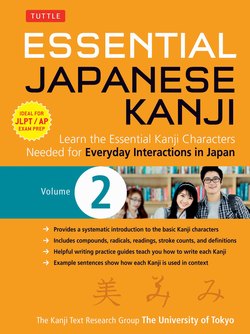Читать книгу Essential Japanese Kanji Volume 2 - University of Tokyo Kanji Research Group - Страница 7
На сайте Литреса книга снята с продажи.
ОглавлениеINTRODUCTION
This book contains 21 lessons introducing 250 kanji. Each lesson focuses on an everyday situation in Japan.
There is a short explanation of kanji and kana before the lessons begin. You will also find the Appendices, the On-Kun Index and the Vocabulary Index useful to refer to as you learn.
A modified Hepburn system of romanization has been used.
Each lesson is composed of the following sections.
1. Introductory Quiz — This section describes situations that you may encounter in daily life, and is followed by a quiz. By referring first to the words in Vocabulary, you’ll learn the readings and the meanings of the words that are introduced in the lesson. And by solving the quiz, you will understand the situation that’s presented. Try the quiz again after the lesson, and you’ll find out how much you have learned.
2. Vocabulary — This section contains the readings and meanings of the words used in the Introductory Quiz. Refer to it when studying the illustrations or taking the quiz. The numeral above each kanji indicates the lesson where the kanji is introduced.
3. New Characters — This section introduces the kanji of the lesson using Kanji Charts with their meanings, basic on-kun readings, stroke orders, etymologies or memory-aid hints, and compounds with their English translations.
The compounds essentially consist of newly or previously introduced kanji. (Kanji that are not included in the 500 taught in the two volumes of this series are marked with ×.) More important compounds are shown in the upper part of the list. However, you are encouraged to study those in the lower part of the list as well. When kana is optionally added to kanji (okurigana), the most common usage is adopted and formal usages are shown in parentheses.
4. Practice — This section provides practice for reading and writing the kanji found mainly in the upper part of the kanji charts. You should use the practice as a final check for the kanji learned in each lesson. Answers to this section are not provided.
5. Advanced Placement Exam Practice Questions — This section provides an exercise similar in format to the College Board’s Advanced Placement examination for Japanese Language and Culture. You can try the exercise after each lesson, or after completing all the lessons.
